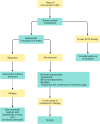Diagnosis and Pharmacological Management of Microscopic Colitis in Geriatric Care
- PMID: 38231321
- PMCID: PMC10869377
- DOI: 10.1007/s40266-023-01094-6
Diagnosis and Pharmacological Management of Microscopic Colitis in Geriatric Care
Abstract
Microscopic colitis, a diagnosis under the umbrella term of inflammatory bowel disease, is a prevalent cause of watery diarrhea, often with symptoms of urgency and bloating, typically observed in older adults aged ≥ 60 years. Its incidence has been reported to exceed those of ulcerative colitis and Crohn's disease in some geographical areas. Although nonpathognomonic endoscopic abnormalities, including changes of the vascular mucosal pattern; mucosal erythema; edema; nodularity; or mucosal defects, e.g., "cat scratches" have been reported, a colonoscopy is typically macroscopically normal. As reliable biomarkers are unavailable, colonoscopy using random biopsies from various parts of the colon is compulsory. Based on the histological examination under a microscope, the disease is divided into collagenous (with a thickened subepithelial collagenous band) and lymphocytic (with intraepithelial lymphocytosis) colitis, although incomplete forms exist. In routine clinical settings, the disease has a high risk of being misdiagnosed as irritable bowel syndrome or even overlooked. Therefore, healthcare providers should be familiar with clinical features and rational management strategies. A 6-8-week oral budesonide treatment course (9 mg/day) is considered the first-line therapy, but patients often experience relapse when discontinued, or might become intolerant, dependent, or even fail to respond. Consequently, other therapeutic options (e.g., bismuth subsalicylate, biologics, loperamide, bile acid sequestrants, and thiopurines) recommended by available guidelines may be prescribed. Herein, clinically meaningful data is provided based on the latest evidence that may aid in reaching a diagnosis and establishing rational therapy in geriatric care to control symptoms and enhance the quality of life for those affected.
© 2024. The Author(s).
Conflict of interest statement
OHN: None, DSP: None.
Figures
References
-
- Aggarwal A, Helper D. Macroscopic findings in lymphocytic colitis. Clin Gastroenterol Hepatol. 2014;12:e65–e66. - PubMed
-
- Marlicz W, Skonieczna-Zydecka K, Yung DE, et al. Endoscopic findings and colonic perforation in microscopic colitis: a systematic review. Dig Liver Dis. 2017;49:1073–1085. - PubMed
-
- Yuan L, Wu TT, Zhang L. Microscopic colitis: lymphocytic colitis, collagenous colitis, and beyond. Hum Pathol. 2023;132:89–101. - PubMed
MeSH terms
Grants and funding
LinkOut - more resources
Full Text Sources
Medical
Research Materials
Miscellaneous



